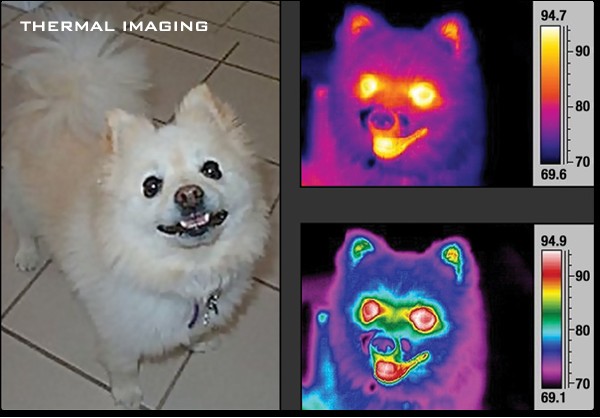Infrared radiation, a type of electromagnetic radiation, differs significantly from visible light, impacting everything from remote controls to astronomical observations. COMPARE.EDU.VN provides an exhaustive comparison, shedding light on their properties, applications, and significance, and guiding you to the information you need. Exploring thermal imaging and infrared astronomy will enhance your understanding of electromagnetic spectrum and radiant energy.
1. Understanding the Electromagnetic Spectrum
The electromagnetic spectrum encompasses a wide range of radiation types, characterized by varying wavelengths and frequencies. Visible light, the portion of the spectrum detectable by the human eye, occupies only a small fraction of this vast range. Infrared radiation, positioned adjacent to visible light on the spectrum, possesses longer wavelengths and lower frequencies. This fundamental difference in wavelength dictates the unique properties and applications of each type of radiation.
1.1 Defining Infrared Radiation
Infrared radiation (IR), often referred to as infrared light, is a type of electromagnetic radiation with wavelengths longer than those of visible light, extending from the red edge of the visible spectrum to the microwave region. While invisible to the human eye, we can perceive infrared radiation as heat. Its wavelength range typically spans from approximately 700 nanometers (nm) to 1 millimeter (mm), bridging the gap between visible light and microwaves.
1.2 Defining Visible Light
Visible light, the portion of the electromagnetic spectrum that humans can see, lies between ultraviolet (UV) and infrared radiation. Its wavelengths range from approximately 380 nm to 750 nm. Different wavelengths within this range correspond to different colors, from violet at the shorter end to red at the longer end. Visible light enables us to perceive the world around us, making it crucial for vision and various technological applications.
1.3 What are electromagnetic waves?
Electromagnetic (EM) waves are disturbances that transfer energy through space. Unlike mechanical waves, such as sound waves, EM waves do not require a medium to propagate. Instead, they are formed by the interaction of electric and magnetic fields. These waves are characterized by their frequency and wavelength. The frequency is the number of wave cycles that pass a point in a given time, while the wavelength is the distance between two consecutive crests or troughs of the wave.
1.4 The Relationship Between Wavelength and Frequency
Wavelength and frequency are inversely proportional in the electromagnetic spectrum. This relationship is described by the equation:
c = λνwhere:
- c is the speed of light (approximately 3.0 x 10^8 meters per second)
- λ is the wavelength
- ν is the frequency
This equation shows that as the wavelength increases, the frequency decreases, and vice versa. Therefore, infrared radiation, with its longer wavelengths, has a lower frequency than visible light.
2. Key Differences Between Infrared Radiation and Visible Light
The fundamental differences between infrared radiation and visible light stem from their distinct wavelengths and frequencies within the electromagnetic spectrum. These variations lead to significant differences in their properties, behavior, and applications.
2.1 Wavelength and Frequency
Infrared radiation possesses longer wavelengths (700 nm to 1 mm) compared to visible light (380 nm to 750 nm). Consequently, infrared radiation has lower frequencies than visible light. This difference in wavelength and frequency dictates how these two types of radiation interact with matter.
2.2 Energy Levels
The energy of electromagnetic radiation is directly proportional to its frequency. Since infrared radiation has a lower frequency than visible light, it also possesses lower energy levels. This means that infrared photons carry less energy than visible light photons.
2.3 Human Perception
Visible light is detectable by the human eye, allowing us to see the world around us. In contrast, infrared radiation is invisible to the naked eye. However, we can perceive infrared radiation as heat, as it causes molecules to vibrate, generating thermal energy.
2.4 Atmospheric Absorption
The Earth’s atmosphere interacts differently with infrared radiation and visible light. Certain atmospheric gases, such as water vapor and carbon dioxide, strongly absorb infrared radiation. This absorption plays a crucial role in regulating Earth’s temperature through the greenhouse effect. Visible light, on the other hand, passes through the atmosphere more readily.
2.5 Applications
Visible light is essential for vision, photography, and illumination. Infrared radiation finds applications in thermal imaging, remote sensing, communication, and heating. The unique properties of each type of radiation make them suitable for distinct purposes.
3. Applications of Infrared Radiation
Infrared radiation has a wide array of applications across various fields, including:
3.1 Thermal Imaging
Thermal imaging, also known as thermography, utilizes infrared cameras to detect and visualize temperature variations. These cameras capture infrared radiation emitted by objects, creating images that represent temperature distributions. Thermal imaging is used in:
- Medical Diagnostics: Detecting inflammation, tumors, and circulatory problems.
- Building Inspection: Identifying insulation deficiencies, water leaks, and electrical issues.
- Law Enforcement: Night vision, surveillance, and search and rescue operations.
- Industrial Maintenance: Detecting overheating equipment, faulty connections, and energy losses.
3.2 Remote Sensing
Remote sensing involves acquiring information about an object or area from a distance, typically using satellites or aircraft. Infrared sensors play a crucial role in remote sensing applications, such as:
- Earth Observation: Monitoring land use, vegetation health, and climate change.
- Weather Forecasting: Tracking cloud formations, temperature patterns, and atmospheric conditions.
- Environmental Monitoring: Detecting pollution, deforestation, and natural disasters.
- Military Intelligence: Surveillance, reconnaissance, and target detection.
3.3 Communication
Infrared radiation is used for short-range communication in various devices, including:
- Remote Controls: Controlling TVs, DVD players, and other electronic devices.
- Wireless Headphones: Transmitting audio signals from a source device.
- Data Transfer: Exchanging files between devices using infrared ports.
3.4 Heating
Infrared heaters emit infrared radiation, which directly heats objects and people without warming the surrounding air. This makes them energy-efficient and effective for:
- Space Heating: Heating rooms, patios, and outdoor areas.
- Industrial Processes: Drying, curing, and heating materials.
- Medical Therapy: Relieving muscle pain, improving circulation, and promoting healing.
3.5 Security Systems
Infrared sensors are commonly used in security systems to detect motion and intrusions. These sensors can detect changes in infrared radiation caused by a person or object moving within their range, triggering an alarm or other security response.
3.6 Spectroscopy
Infrared spectroscopy is a technique used to identify and study molecules based on their infrared absorption and transmission spectra. Different molecules absorb infrared radiation at different frequencies, creating a unique fingerprint that can be used to identify the molecule.
4. Applications of Visible Light
Visible light is indispensable for numerous aspects of our lives, encompassing:
4.1 Vision
Visible light is the foundation of human vision, allowing us to perceive the world around us. The lens in our eye focuses light onto the retina, which contains photoreceptor cells that convert light into electrical signals. These signals are then transmitted to the brain, where they are interpreted as images.
4.2 Photography
Photography relies on visible light to capture images. Cameras use lenses to focus light onto a sensor, which records the intensity and color of the light. This information is then used to create a photograph.
4.3 Illumination
Visible light is used for illumination in homes, offices, streets, and vehicles. Light sources, such as incandescent bulbs, fluorescent lamps, and LEDs, emit visible light to provide illumination.
4.4 Displays
Visible light is used in various display technologies, including:
- Computer Monitors: Displaying images and text on a screen.
- Television Screens: Displaying video content.
- Mobile Phone Screens: Displaying information and applications.
- Projectors: Projecting images onto a large screen.
4.5 Art and Design
Visible light plays a crucial role in art and design. Artists use visible light to create paintings, sculptures, and other works of art. Designers use visible light to create aesthetically pleasing and functional spaces.
4.6 Plant Growth
Visible light is essential for plant growth through photosynthesis. Plants use chlorophyll to absorb visible light, which is then used to convert carbon dioxide and water into glucose and oxygen.
5. Exploring the Advantages and Disadvantages
Both infrared radiation and visible light offer unique advantages and disadvantages, which dictate their suitability for various applications.
5.1 Infrared Radiation: Advantages and Disadvantages
| Feature | Advantage | Disadvantage |
|---|---|---|
| Penetration | Can penetrate certain materials that are opaque to visible light, such as smoke, dust, and some fabrics. | Limited penetration through dense materials and water. |
| Detection | Can be detected in the absence of visible light, making it ideal for night vision and surveillance. | Invisible to the human eye, requiring specialized sensors for detection. |
| Thermal Sensing | Sensitive to heat, allowing for thermal imaging and temperature measurement. | Can be affected by ambient temperature and thermal noise, requiring careful calibration and signal processing. |
| Communication | Can be used for short-range wireless communication, such as remote controls. | Limited range and susceptible to interference from other infrared sources. |



5.2 Visible Light: Advantages and Disadvantages
| Feature | Advantage | Disadvantage |
|---|---|---|
| Visibility | Easily detected by the human eye, making it ideal for vision and illumination. | Limited penetration through opaque materials. |
| Imaging | Provides high-resolution imaging and color information. | Requires the presence of light, making it ineffective in dark environments. |
| Photosynthesis | Essential for plant growth through photosynthesis. | Can be harmful to the eyes at high intensities. |
| Display Technology | Used in various display technologies, such as computer monitors, television screens, and mobile phones. | Can be affected by ambient light conditions, requiring adjustments to brightness and contrast. |
6. Safety Considerations for Infrared Radiation and Visible Light
While both infrared radiation and visible light are generally safe at low intensities, exposure to high levels can pose potential health risks.
6.1 Infrared Radiation Safety
- Thermal Burns: Prolonged exposure to intense infrared radiation can cause thermal burns to the skin and eyes.
- Eye Damage: Intense infrared radiation can damage the cornea, lens, and retina of the eye.
- Skin Aging: Chronic exposure to infrared radiation may contribute to premature skin aging.
To mitigate these risks, it is essential to:
- Limit exposure to high-intensity infrared sources.
- Wear appropriate protective eyewear when working with infrared lasers or high-intensity infrared lamps.
- Use thermal imaging equipment with caution, avoiding prolonged exposure to the infrared source.
6.2 Visible Light Safety
- Eye Strain: Prolonged exposure to bright visible light can cause eye strain, headaches, and blurred vision.
- Photokeratitis: Exposure to intense UV light, often associated with visible light sources like welding arcs, can cause photokeratitis (sunburn of the cornea).
- Retinal Damage: High-intensity visible light can damage the retina, leading to vision loss.
To minimize these risks, it is advisable to:
- Use appropriate lighting levels for tasks.
- Avoid staring directly at bright light sources.
- Wear sunglasses with UV protection when exposed to sunlight.
- Use appropriate eye protection when working with high-intensity visible light sources, such as lasers or welding arcs.
7. Future Trends in Infrared Radiation and Visible Light Technologies
Both infrared radiation and visible light technologies are continuously evolving, driven by advancements in materials science, electronics, and photonics. Some prominent trends include:
7.1 Infrared Radiation
- Advanced Thermal Imaging: Development of higher-resolution, more sensitive, and more affordable thermal imaging cameras for various applications.
- Infrared Spectroscopy: Expanding the use of infrared spectroscopy for material identification, environmental monitoring, and medical diagnostics.
- Infrared Communication: Exploring new infrared communication protocols for faster and more secure data transfer.
- Infrared Heating: Improving the efficiency and control of infrared heating systems for industrial and residential applications.
7.2 Visible Light
- LED Lighting: Continued improvements in the efficiency, color rendering, and lifespan of LED lighting.
- OLED Displays: Development of flexible, transparent, and energy-efficient OLED displays for various applications.
- Li-Fi Technology: Exploring the use of visible light for high-speed wireless communication (Li-Fi).
- Advanced Microscopy: Enhancing the resolution and capabilities of visible light microscopes for biological and materials research.
8. Optimizing Your Choices with COMPARE.EDU.VN
Making informed decisions requires a comprehensive understanding of the options. Whether you’re comparing infrared technology against visible light applications, COMPARE.EDU.VN equips you with detailed comparisons.
8.1 Understanding Your Needs
Before diving into comparisons, consider what matters most to you. Are you looking for energy efficiency, specific health benefits, or perhaps the best technology for security? Understanding your priorities will streamline your decision-making process.
8.2 Leveraging Detailed Comparisons
COMPARE.EDU.VN offers side-by-side comparisons that highlight the strengths and weaknesses of each option. The comparisons cover a wide array of attributes such as technology, cost, safety, and environmental impact, giving you a holistic view.
8.3 Making an Informed Decision
Equipped with detailed comparisons, you are empowered to make an informed decision. Consider how each option aligns with your needs and priorities. This approach ensures that your final choice is well-reasoned and satisfies your objectives.
9. FAQs About Infrared Radiation and Visible Light
9.1. Is infrared radiation harmful to humans?
Infrared radiation can be harmful at high intensities, causing thermal burns and eye damage. However, low levels of infrared radiation, such as those emitted by remote controls, are generally safe.
9.2. Can infrared radiation be used for night vision?
Yes, infrared radiation is used in night vision devices to detect heat signatures from objects and create images in low-light conditions.
9.3. What are the main applications of visible light?
Visible light is used for vision, photography, illumination, displays, and various other applications.
9.4. How does infrared heating work?
Infrared heaters emit infrared radiation, which directly heats objects and people without warming the surrounding air.
9.5. What is the difference between near-infrared and far-infrared radiation?
Near-infrared radiation has shorter wavelengths and higher energy levels than far-infrared radiation. Near-infrared is often used in communication and remote sensing, while far-infrared is used in thermal imaging and heating.
9.6. Can infrared radiation penetrate clouds?
Infrared radiation can penetrate some types of clouds, but it is significantly absorbed by water vapor in the atmosphere.
9.7. What is the role of infrared radiation in the greenhouse effect?
Certain atmospheric gases, such as water vapor and carbon dioxide, absorb infrared radiation emitted by the Earth’s surface, trapping heat and contributing to the greenhouse effect.
9.8. How is infrared radiation used in medical diagnostics?
Thermal imaging can detect inflammation, tumors, and circulatory problems by measuring temperature variations in the body.
9.9. What are the advantages of LED lighting over traditional lighting?
LED lighting is more energy-efficient, has a longer lifespan, and offers better color rendering compared to traditional lighting.
9.10. What is Li-Fi technology?
Li-Fi technology uses visible light for high-speed wireless communication, offering potential advantages over traditional Wi-Fi in terms of speed, security, and bandwidth.
10. Taking the Next Step with COMPARE.EDU.VN
Ready to make a well-informed decision? Don’t navigate the complexities alone. Visit COMPARE.EDU.VN today for comprehensive comparisons and detailed insights that will help you choose the best option for your needs. Our resources simplify the decision-making process, ensuring you find the perfect match.
For more information, visit our website at COMPARE.EDU.VN or contact us at +1 (626) 555-9090. Our office is located at 333 Comparison Plaza, Choice City, CA 90210, United States. Let compare.edu.vn guide you to the best choice.
